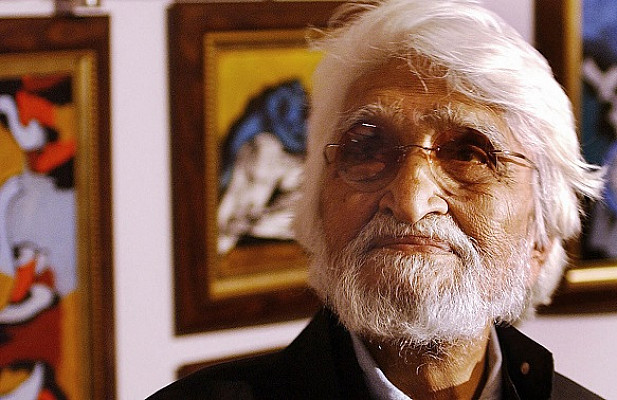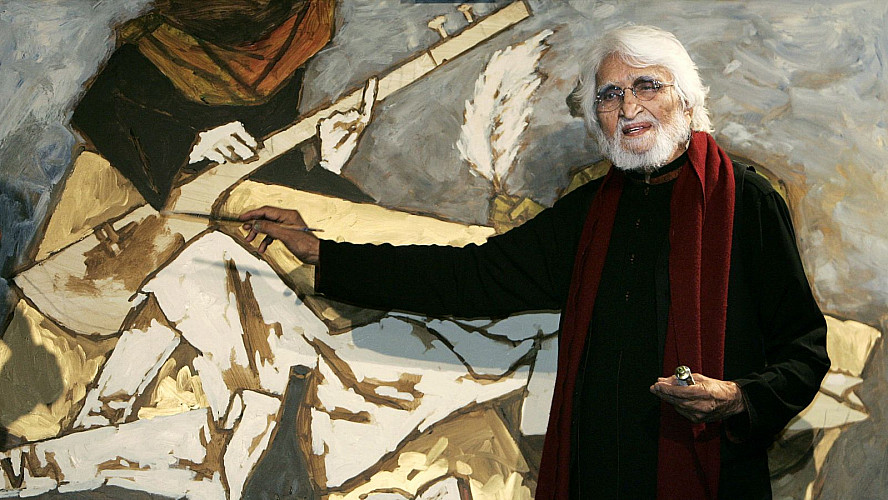M F Husain: The River Runs Through It
The lobby of the Jumeirah Emirates Towers in Dubai is bathed in afternoon light filtering through the glass atrium. Freshly from Mumbai and already checked into the hotel, I walk in, for a much-needed cup of tea and I discover myself seated one table away from M F Husain, India’s painter-in-self-exile. I am so excited; I walk right up to him and his pretty companion. He smiles and waves me into a chair. I remind him of several interviews that I had with him, as a young reporter with a popular city magazine. I remind him about the morning many years ago, when he strolled into t he magazine office that I was with then, blank canvas under his arm. He had set it up against a wall and painted his heart out. That canvas provided much inspiration for us cub reporters, for the many years that it hung on the editor’s wall. I talk about the time he ‘stood me up’ mid-interview for two hours while I waited with the patience and desperation of the very young. That is Husain – impulsive, quick, unmatchable. And he believes in spreading the message of his paintings everywhere. Heck, his paintings are the message!
At 95, he is resplendent as ever, his shock of white hair perhaps just a little less luxuriant, his beard white and shorter-styled than I remember. He is wearing all-blue – blue lungi, blue kurta and a flowing blue coat of the same fabric that adds the requisite touch of drama. And as is inevitable with those who stumble onto the artist, I look at his feet. (For had he not been famously cast out of a South Bombay club for being barefoot, so many years ago.) Black socks. No shoes. In his pocket, lies his iPhone. In his hand with the gnarled nails embedded with paint, he holds aloft a giant paintbrush that I mistake for a walking stick made to look like a paintbrush. This is not so, he informs me later, impatient with my meaningless question. This is a paintbrush, made in France where painters and creative people are revered, and he carries it because it makes him feel good. “If a general can carry his stick, why can’t I carry my paintbrush every where!” His logic, too, has remained impeccable.
To my delight, he accedes to an interview. I have no idea when I meet him the following day that M F Husain, India’s foremost artist, would soon accept the offer made to him of Qatar citizenship. Had he decided already? I guess so. Though he did not mention it. He chose to make a short, though meaningful announcement in The Hindu, a few days later, above a line drawing of a horse, his trademark silhouette: ‘I the Indian origin painter M F Husain, at 95, have been honoured by Qatar nationality’. The furor in India established his celebrity as waves of news coverage presented artists, politicians, religious leaders in heated debate. Journalists and columnists rushed to get their voices heard. Had he betrayed India? Had India betrayed him? Had the government let him down?
“I am an Indian painter wherever I am,” he assured on national television. “I don’t need to be here physically. I have 20-30,000 paintings in India which I have given to the country that I love. I could have given them to any other country but did not….”
As for me, having spoken to him so recently and gauged his mood, having realised his urgency to work and to work in the right setting, with the right funding to facilitate his plans, I cannot grudge him his decision. He seems to have reached that point in his life where he has rejected all else, in order to put his work out there, for the world to take note of. He has realised the immortality of his work. And in doing so, his own mortality. It is as if he is racing against time to transfer onto canvas all the creativity that lies inside of him. “In a lifetime of 80-90 years, time is minuscule,” he says. “I feel as though I have lived here for one minute, that is all.”
Excerpts from the interview….
On his self-exile, following protests by Hindu fundamentalists
“I came out here five years ago, to facilitate my work on three major projects. I am painting the Indian civilisation from Mohenjodaro to Manmohan Singh; the Arab civilisation from the time of Babylon and the history of Indian cinema, which next year completes 100 years. I want to do these on a museum level and it is not possible for me to do this in India; the political and social climate does not allow it. The tax structure is so complicated that I had to become an NRI. But this is not so in India only. (Swedish director) Ingmar Bergman, the great master, due to tax reasons, had to leave the country. Tax is like a demon. The only country that respects the artist in this way is France which is a centre of art and culture. I don’t understand why this happens because finally culture is what remains, not money.
“India has such a rich tradition of art but our politicians are blind. Only a few, like Indira Gandhi, have had an eye for it. After that, there is no one. This is a big drawback…. I have painted more than 200 paintings in the last five years. I like to create history. I am not painting for art dealers to sell or to decorate private homes. The government says they will give me security…but this is a political thing. It is very dangerous.
“I did not come here because of the trouble in India. I came here much earlier. A political minuscule of people creating nuisance is of no value. But, the passion is inside and I needed a sponsor for all my projects which I found in London with the Mittals, and the Sheikhs in Abu Dhabi and Qatar. I came here to continue my work. The people of India love my work, except for a few misguided people. The Supreme Court has already given a judgement quashing their cases which was like a slap in their face.”
On where he calls home
“For 60 years I am roaming around the world. I have no studio anywhere in the world. Millions of things inspire me every day – that’s why I can’t sit still. This I’ve been doing all my life. I don’t have a home anywhere. My wife died 15 years ago, after that I have no house. I don’t have a bedroom of my own anywhere. As long as you are busy creating, you can live anywhere. Even in the jungle. I am not bound by time; I am not assigned to anything.
“The way people are drawn to my paintings…all the time, they come to me. If there are a 100 people around me and if they all ask for my signature, I give it. They come with such affection. This is God’s gift to me.”
On his family
“My whole family is like me. They have given me tremendous freedom. My youngest son is making a movie on me. He is writing the script. It will be a musical based on my life. Musicals have universal appeal. For the films I make (Meenaxi, A Tale of Three Cities, Gaja Gamini), I write the script, dialogue, everything. I write in Urdu and someone translates it into English. I don’t compose the music though.”
On his muses
“There is no such thing as a muse. The media creates all these things. Kajol is not a muse. Madhuri Dixit is not a muse. We are both artists – painter and actor. We have a relationship as artists. Was Mother Teresa a muse?”
On young Indian artists
“What is being done in India is dynamic. It is tremendous, better than anywhere else in the world. In the West, they have reached a point where they do not know where to go. They can make a heap of garbage and call it art. This is junk culture. India has had artists like Gaitonde, Ram Kumar who have dedicated their lives to art. They did not take their money and go. Many of them are active even today.”
On Indian cinema
“Cinema is a major force in India and reflects the common man, the spirit of the country and its ethos. The most terrible film I have seen in recent times is My Name is Khan. The best film of the last 20 years is 3 Idiots. I watched it maybe six or seven times. In cinema, I am only concerned with Indian concepts. Of the new actors and actresses, I like Ranbir (Kapoor). He is very natural, very fresh. Only thing, he belongs to the Kapoor clan. There was not a single actor among them. They were all clowns. But then Charlie Chaplin was the greatest clown of them all and he was the greatest entertainer. Raj Kapoor was a great showman; Ranbir should not fall into the Kapoor trap.”
On being called the Picasso of India
“Only those who are ignorant call me that. I laugh at them when they say this.”
Back in that hotel lobby, two young men in suits excuse themselves and take pictures on their camera phones with Husain. He is happy to pose. I request an autograph. I am disappointed that he does not choose to do a line drawing of a horse, as he sometimes does. He has signed his name in Hindi, Urdu and English and it is only days later, when he gives up his Indian nationality (as he claims, it is only a formality on paper) that I realise the significance of what he has done.
Related posts from Verve:
Verve Trending
Sorry. No data so far.
us on Facebook to stay updated with the latest trends







